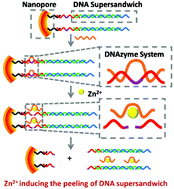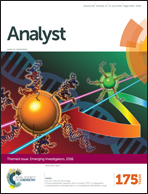Sensitive Zn2+ sensor based on biofunctionalized nanopores via combination of DNAzyme and DNA supersandwich structures†
Abstract
The sensitivity of detection based on biofunctionalized nanopores is limited since the target-to-signal ratio is 1 : 1. Isothermal amplification is a promising amplification strategy at constant temperature due to its easy operation, quick results, PCR-like sensitivity, low cost and energy efficiency. In the present work, the isothermally amplified detection of Zn2+ is achieved by using a DNA supersandwich structure and Zn2+-requiring DNAzymes. The DNA supersandwich structures, due to the multiple amplification of nucleic acids, heavily plug the nanopore. Simultaneously, the DNA supersandwich structures bond with the sessile probe (SP) of the substrate in the nanopore which partially hybridizes with DNAzymes. In the presence of Zn2+, the Zn2+-requiring DNAzyme cleaves the SP into two fragments, while the DNA supersandwich structures are peeled off and the ionic pathway is unimpeded. A steep drop and a sequential complete recovery of the current occur in the I–V plot when the DNA supersandwich structures are decorated and peeled off. In the present system, the reliable detection limit of Zn2+ is as low as 1 nM. Discrimination between different types of ions (Cu2+, Hg2+, Pb2+) is achieved.

- This article is part of the themed collection: Emerging Investigators

 Please wait while we load your content...
Please wait while we load your content...